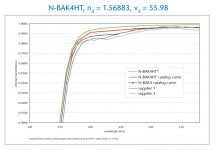Hermann
Well-known member

There's a .001% chance that I misremembered what he said, but if true, and I see no reference to an A-K prism update in Leica's PR, just a follow-the-leader HT glass upgrade, which means that HT glass can be used to make S-P prisms. There's some 'splainin' someone needs to do.
Nobody said that HT *can't* be used for SP prisms. Only that it doesn't make much sense.
Zeiss has come out with two different lines of bins - the 56 Conquest HDs and the 54 HTs - while neglecting to update their 32mm FLs, which surely would lead in sales vs. the oversized HDs and HTs.
No, it wouldn't lead in sales vs. the large HDs and HTs. You underestimate the market for 56mm and 54mm bins in Europe. Most hunters here go for the big boys.
Users and reviewers have been moaning about the UV's light transmission being behind the other top bananas, so this might quell those complaints.
Perhaps. But on the other hand, it might not, now that so many people seem to find sharpness at the edge important.
Hermann







